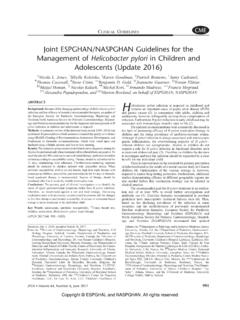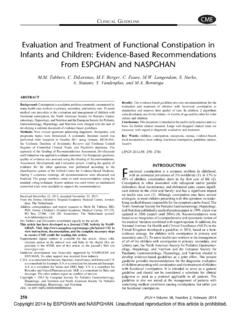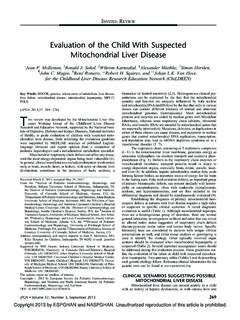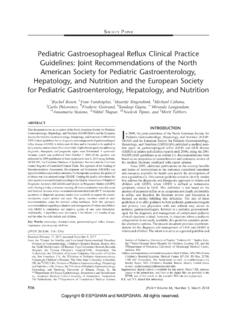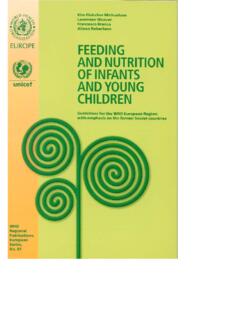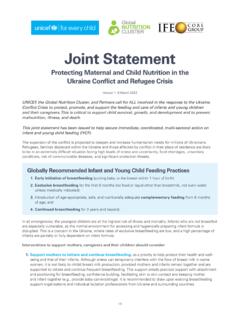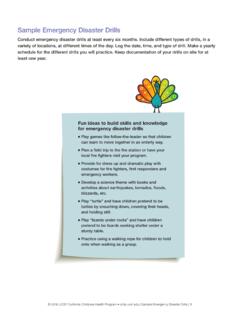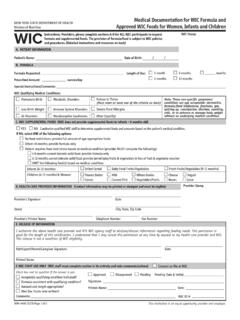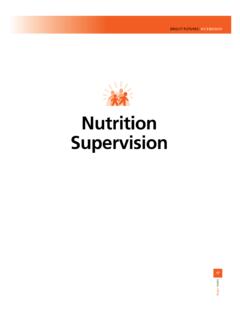Transcription of Evaluation and Treatment of Functional ... - NASPGHAN
1 Copyright 2014 by ESPGHAN and NASPGHAN . Unauthorized reproduction of this article is and Treatment of Functional Constipation inInfants and Children: Evidence-Based RecommendationsFrom ESPGHAN and Tabbers, C. DiLorenzo, Berger, C. Faure, Langendam, S. Nurko,A. Staiano, Y. Vandenplas, and BenningaABSTRACTB ackground:Constipation is a pediatric problem commonly encountered bymany health care workers in primary, secondary, and tertiary care. To assistmedical care providers in the Evaluation and management of children withfunctional constipation, the North American Society for Pediatric Gastro-enterology, Hepatology, and nutrition and the European Society for PediatricGastroenterology, Hepatology, and nutrition were charged with the task ofdeveloping a uniform document of evidence-based :Nine clinical questions addressing diagnostic, therapeutic, andprognostic topics were formulated.
2 A systematic literature search wasperformed from inception to October 2011 using Embase, MEDLINE,the Cochrane Database of Systematic Reviews and Cochrane CentralRegister of Controlled Clinical Trials, and PsychInfo databases. Theapproach of the Grading of Recommendations Assessment, Developmentand Evaluation was applied to evaluate outcomes. For therapeutic questions,quality of evidence was assessed using the Grading of Recommendations,Assessment, Development, and Evaluation system. Grading the quality ofevidence for the other questions was performed according to theclassification system of the Oxford Centre for Evidence-Based 3 consensus meetings, all recommendations were discussed andfinalized. The group members voted on each recommendation, using thenominal voting technique. Expert opinion was used where no randomizedcontrolled trials were available to support the :This evidence-based guideline provides recommendations for theevaluation and Treatment of children with Functional constipation tostandardize and improve their quality of care.
3 In addition, 2 algorithmswere developed, one for the infants<6 months of age and the other for olderinfants and :This document is intended to be used in daily practice and as abasis for further clinical research. Large well-designed clinical trials arenecessary with regard to diagnostic Evaluation and Words:children, constipation, encopresis, enema, evidence-based,fecal incontinence, fecal soiling, Functional constipation, guideline, infants,laxative(JPGN2014;58: 258 274)INTRODUCTIONF unctional constipation is a common problem in childhood,with an estimated prevalence of 3% worldwide (1). In 17% to40% of children, constipation starts in the first year of life (2).Constipation is often associated with infrequent and/or painfuldefecation, fecal incontinence, and abdominal pain; causes signifi-cant distress to the child and family; and has a significant impacton health care cost (3).
4 Although constipation may have severaletiologies, in most children presenting with this symptom no under-lying medical disease responsible for the symptom can be found. TheNorth American Society for Pediatric Gastroenterology, Hepatology,and nutrition published a medical position paper in 1999, which wasupdated in 2006 (search until 2004) (4). Recommendations werebased on an integration of a comprehensive and systematic review ofthe medical literature combined with expert opinion. In addition, theNational Institute for Health and Clinical Excellence (NICE) in theUnited Kingdom developed a guideline in 2010, based on a best-evidence strategy, for children with constipation in primary andsecondary care (5). To assist health care workers in the managementof all of the children with constipation in primary, secondary, andtertiary care, the North American Society for Pediatric Gastroenter-ology, Hepatology, and nutrition and the European Society forPaediatric Gastroenterology, Hepatology, and nutrition elected todevelop evidence-based guidelines as a joint effort.
5 The presentguideline provides recommendations for the diagnostic evaluationof children presenting with constipation and the Treatment of childrenwith Functional constipation. It is intended to serve as a generalguideline and should not be considered a substitute for clinicaljudgment or used as a protocol applicable to all patients. Theguideline is also not aimed at the management of patients withunderlying medical conditions causing constipation, but rather justfor Functional November 23, 2013; accepted November 25, the Emma Children s Hospital/Academic Medical Center, Amster-dam, The correspondence and reprint requests to Merit M. Tabbers, MD,PhD, Emma Children s Hospital/Academic Medical Centre, H7-250,PO Box 22700, 1100 DD Amsterdam, The Netherlands Tabbers and DiLorenzo contributed equally to the article has been developed as a Journal CME Activity by NASP-GHAN.
6 Instructions, documentation, and the complete necessary stepsto receive CME credit for reading this digital content is available for this article. Direct URLcitations appear in the printed text, and links to the digital files areprovided in the HTML text of this article on the journal s Web site( ).Guideline development was financially supported by NASPGHAN andESPGHAN. No other support was received from is a consultant for Janssen, Sucampo, AstraZeneca, and Ironwood. a consultant for Sucampo. is a consultant for Janssen and is a consultant for Valeas and DMG Italy. is a consultant forBiocodex and United Pharmaceuticals. is a consultant for Shire andSucampo. The other authors report no conflicts of #2014 by European Society for Pediatric Gastroenterology,Hepatology, and nutrition and North American Society for PediatricGastroenterology, Hepatology, and NutritionDOI: Volume 58, Number 2, February 2014 Copyright 2014 by ESPGHAN and NASPGHAN .
7 Unauthorized reproduction of this article is Search and Grading the Articles forQuality of EvidenceThe project started in September 2011 by formulating 9clinical questions (Table 1). Seven questions were chosen based onthe Dutch guidelines for Functional constipation (6). In addition, 2new questions were added to the present guidelines: questions 5 and8. After the questions were formulated, the guidelines committeewas subdivided into subgroups that dealt with each questionseparately. Questions 1 and 2 were answered based on expertopinions and earlier published guidelines (5 9). Questions 3 to 9were answered using the results of systematic literature literature searches were performed by a clinicallibrarian from inception to October 2011. The Embase, MEDLINE,Cochrane Database of Systematic Reviews and Cochrane CentralRegister of Controlled Clinical Trials, and PsychInfo databaseswere inclusion criteria were as population consisting of children of ages 0 to 18 years inwhom Functional constipation was diagnosed, treated, or itscourse followed.
8 The key words used to describe constipationwere constipation, obstipation, faecal/fecal inconti-nence, coprostasis, encopresis, and soiling. Excludedwere the studies concerning children with organic causes ofconstipation and children with exclusively Functional non-retentive fecal clear definition of Functional constipation had to be providedby the evaluate the value of tests in diagnosing functionalconstipation (question 3), we included systematic reviewsand original studies related to the diagnostic accuracy of thespecific tests. The reference standard for Functional constipationhad to be defined by the authors in terms of findings at historyand physical studies evaluating the effects of treatments or interventions(questions 6, 7, and 8), the following inclusion criterion wasused: systematic reviews of randomized controlled trials(RCTs) and/or RCTs containing at least 10 individuals per studies evaluating the outcome of Functional constipation(questions 4, 5, and 9), the following inclusion criteria wereused: systematic reviews of prospective or retrospectivecontrolled studies and original studies with a follow-up of atleast 8 additional strategy to identify studies involved searchingthe reference lists of review articles and included studies.
9 Nolanguage restriction was applied. Furthermore, all of the guidelinesmembers were asked to search the literature with respect to theirassigned topics to possibly uncover further studies that may havebeen missed by the former approach of the Grading of Recommendations, Assess-ment, Development, and Evaluation (GRADE) was used to identifyoutcomes (10). A draft version was circulated by , and everyworkgroup member was allowed to add outcomes. Group memberswere asked to rate relative importance of the outcomes on a 9-pointscale: limited (1 3), important but not critical (4 6), or critical(7 9) for decision making. The workgroup members were alsoasked to discuss personal experience. Based on the answers of theguidelines group members and patient preferences from a focusgroup, 8 outcome measures were selected: pain during defecation,defecation 3 times per week, fecal incontinence frequency,difficulty with defecation, worsening constipation, quality of life,possible harm from laxatives (cancer, tolerance, adverse effects),and abdominal levels and quality of evidence were assessed using theclassification system of the Oxford Centre for Evidence-BasedMedicine ( ) (diagnostic and prognostic ques-tions) and the GRADE system (therapeutic questions) and aresummarized in the online-only appendix ( ).
10 Grades of evidence for each statement are based onthe grading of the literature. If no therapeutic studies were found, wedecided to define the quality of evidence as low. TABLE 1. Overview of the 9 clinical questionsQuestion 1: What is the definition of Functional constipation?Question 2: What are the alarm signs and symptoms that suggest thepresence of an underlying disease causing the constipation?Question 3: In the diagnosis of Functional constipation in children,what is the diagnostic value Digital rectal examination? Abdominal radiography? CTT? Transabdominal rectal ultrasonography?Question 4: Which of the following diagnostic tests should be performedin children with constipation in order to diagnose an underlyingdisease? Laboratory investigations to diagnose (cow s milk) allergy, celiacdisease, hypothyroidism and hypercalcemia?


